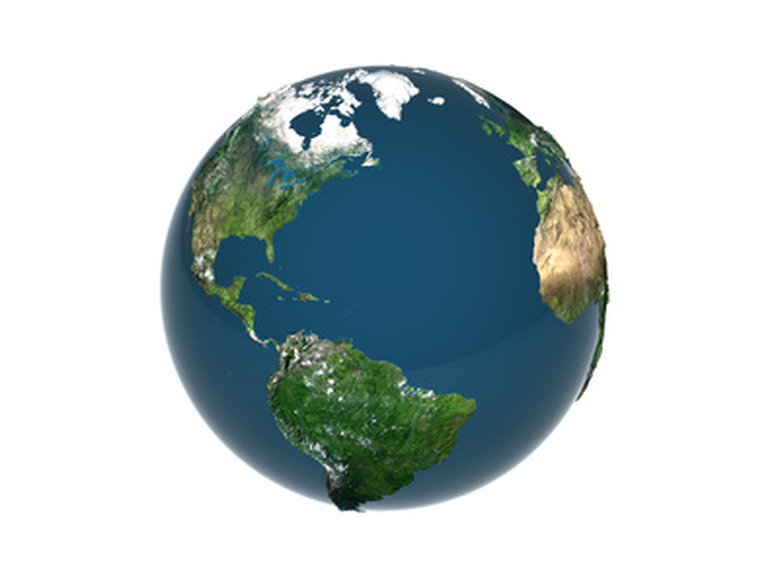What Causes Convection Currents On The Mantle?
When Alfred Wegener first proposed that continents had drifted into their current positions, few people listened. After all, what possible force could move something as large as a continent?
While he didn't live long enough to be vindicated, Wegener's hypothesized continental drift evolved in the theory of plate tectonics. One mechanism for moving the continents involves convection currents in the mantle.
Heat Transfer, or Moving Heat
Heat Transfer, or Moving Heat
Heat moves from areas of higher temperature to areas of lower temperature. The three mechanisms for heat transfer are radiation, conduction and convection.
Radiation moves energy without contact between particles, like the radiation of energy from the Sun to the Earth through the vacuum of space.
Conduction transfers energy from one molecule to another through contact, without particle movement, as when sun-warmed land or water heats the air directly above.
Convection occurs through the movement of particles. As particles become heated, the molecules move faster and faster, and as molecules move apart, density decreases. The warmer, less dense material rises compared to the surrounding cooler, higher density material. While convection generally refers to the fluid flow occurring in gases and liquids, convection in solids like the mantle occurs but at a slower rate.
Convection Currents in the Mantle
Convection Currents in the Mantle
Heat in the mantle comes from the Earth's molten outer core, decay of radioactive elements and, in the upper mantle, friction from descending tectonic plates. The heat in the outer core results from residual energy from the Earth's formative events and the energy generated by decaying radioactive elements. This heat warms the base of the mantle to an estimated 7,230°F. At the mantle-crust boundary. the mantle's temperature is an estimated 392°F.
The temperature difference between the upper and lower boundaries of the mantle requires heat transfer to occur. While conduction seems the more obvious method for heat transfer, convection also occurs in the mantle. The warmer, less dense rock material near the core slowly moves upward.
Relatively cooler rock from higher in the mantle slowly sinks toward the mantle. As the warmer material rises, it also cools, eventually pushed aside by warmer rising material and sinking back toward the core.
Mantle material flows slowly, like thick asphalt or mountain glaciers. While the mantle material remains solid, the heat and pressure allow convection currents to move the mantle material. (See Resources for a mantle convection diagram.)
Moving the Tectonic Plates
Moving the Tectonic Plates
Plate tectonics provides an explanation for Wegener's drifting continents. Plate tectonics, in brief, states that the Earth's surface is broken into plates. Each plate consists of slabs of lithosphere, the rocky outer layer of the Earth, that includes the crust and uppermost mantle. These lithospheric pieces move on top of the asthenosphere, a plastic layer within the mantle.
Convection currents within the mantle provide one potential driving force for plate movement. The plastic movement of the mantle material moves like the flow of mountain glaciers, carrying the lithospheric plates along as the convection movement in the mantle moves the asthenosphere.
Slab pull, slab (trench) suction and ridge push may also contribute to plate movement. Slab pull and slab suction mean that the mass of the descending plate pulls the trailing lithospheric slab across the asthenosphere and into the subduction zone.
Ridge push says that as the less dense new magma rising into the center of oceanic ridges cools, the density of the material increases. The increased density accelerates the lithospheric plate toward the subduction zone.
Convection Currents and Geography
Convection Currents and Geography
Heat transfer also occurs in the atmosphere and hydrosphere, to name two layers of earth in which convection currents take place. Radiant heating from the Sun warms the surface of the Earth. That warmth transfers to the adjacent air mass via conduction. The warmed air rises and is replaced by cooler air, creating convection currents in the atmosphere.
Similarly, water warmed by the sun transfers heat to lower water molecules through conduction. As air temperatures fall, however, the warmer water below moves back toward the surface and the colder surface water sinks, creating seasonal convection currents in the hydrosphere.
In addition, the Earth's rotation moves warm water from the equator toward the poles, resulting in ocean currents that move heat from the equator to the poles and pushes cold water from the poles toward the equator.
References
- Tulane University: Continental Drift, Sea Floor Spreading and Plate Tectonics
- Georgia State University: HyperPhysics Concepts – Heat Transfer
- Georgia State University: HyperPhysics Concepts – Stefan-Boltzmann Law and Heat Radiation
- Tulane University: Structure of the Earth and the Origin of Magmas
- U.S. Energy Information Administration: Geothermal Explained
- Nuclear-Power.net: What is Convection – Definition of Convection
- University of California – Santa Barbara: The Troposphere
- Tulane University: The Ocean – Atmosphere System
Cite This Article
MLA
Blaettler, Karen G. "What Causes Convection Currents On The Mantle?" sciencing.com, https://www.sciencing.com/causes-convection-currents-mantle-6581412/. 2 September 2019.
APA
Blaettler, Karen G. (2019, September 2). What Causes Convection Currents On The Mantle?. sciencing.com. Retrieved from https://www.sciencing.com/causes-convection-currents-mantle-6581412/
Chicago
Blaettler, Karen G. What Causes Convection Currents On The Mantle? last modified March 24, 2022. https://www.sciencing.com/causes-convection-currents-mantle-6581412/
